Why not host a Tapas and Rioja Wine Tasting for your next party?
Spain is producing some excellent value wines and have modernized some of their viticulture techniques to appeal to the wider public. Here is what you need to have a fun evening exploring the food and wine of Spain's Rioja region.
Wine Tasting
While Rioja is most famous for red wines they do produce white wines as well. You can decide if you want to focus on Red only or Red and White.
Basically you are going to:
- Select a wine from each of the Rioja categories as explained below. If you want to limit the number of bottles to taste then skip the youngest category since they will be the least complex. You don't want to miss out on experiencing the Gran Reserva at the top end!
- Select some tapas from the list below to serve with your wine.
- Use the wine notes below to guide you in your tasting and understanding of the wines you are tasting. If you like you can Google the name of the wine+vintage year+review you choose and see what the wine critics are saying about your wine. I would suggest you do the tasting and note your own findings and reactions before you read the critic's reviews so you are not overly influenced by what you read. (If you search 'rioja' in this site you will also find high value recommendations I have made in the past).
- Invite friends to enjoy with you! To keep it simple you may suggest sharing the wine costs and have everyone bring a tapa.
Tasting the Wines
- Provide note paper and pens so people can jot down their impressions of look, aroma and taste of the wine.
- Number the wine bottle and your wine glasses 1-4 so you can keep track of which wine is which. Believe me as the evening wears on you will get them mixed up. Numbering the glasses and bottles ensures you really are talking about the right wine!
- Ideally you will pour a 1-2 oz sample of each of the wines at the same time. So if you are tasting 4 wines you will want 4 glasses the same. Having the same glass for each wine will ensure the variation you are getting from one wine to the other is due to the wine's characteristics and not because the shape or size of the glass is affecting the way the wine unfolds.
- If you are tasting reds and whites then you may want to break them into flights and pour the whites and then the reds.
- Go through the tasting cycle before you eat any of the tapas. Experience the wines on a clean palate first and then note how they change when paired with food. (Hint- plain white bread or crackers or carrots will cleanse your palate).
- Start with the youngest or lightest wines first and work your way up to the bigger wines.
- Start by looking at the wine and noting differences in colour and clarity. Look at the rim of the wine to look for any change in colour. Older wines may have a brick coloured rim.
- Smell the wine. Smell it before swirling the wine in the glass. Take some short sniffs. Swirl the wine in the glass (which will aerate the wine and release more aromas) and repeat. Close your eyes and think about what aromas you are getting
- Taste the wine. Swirl the wine in your mouth and think about the sensations and flavours.
- Use this Wine Aroma Wheel and the Wine Descriptors charts to help you describe and understand what you are tasting.
How to find wines available in Ontario
If you are purchasing your wine in Ontario, Canada you can use the LCBO search site. Type in ' rioja' in the product search field. It will bring you up a list of the riojas the LCBO has on record. From this list you will choose
- a wine labeled simply as 'Rioja';
- a wine labeled 'Crianza'
- a wine labeled Reserva
- a wine labeled Gran Reserva
When you click on a selected wine you will be brought to a screen where you can search for inventory near you. Enter your postal code when prompted and you will get a list of LCBO stores that have the selected wine in stock showing the number of bottles in stock and the number of kilometers the store is from your location. Note - if the lists says one bottle in stock I would call before making a special trip to the store in case it is an 'inventory glitch'.
Wine Notes for Rioja wine tasting
Region
Rioja is an interior region of Spain, sheltered by the Pyrennees mountain range.
Spanish wines have 3 quality categories - vino de mesa or table wine, vino de la tierra or regional wine or vino de calidad or quality wine. Rioja wines are all considered to be quality wines.
Within the 'quality wine' designation there are 2 classifications of Denominaciones de Origen (DO) or Denominaciones de Origen Calificada (DOC) sometimes also indicated by DOCa or DOQ. DOC is the highest wine category according to Spanish wine law, with particularly stringent quality controls, and so far has only been awarded to Rioja and Priorat regions.
Red Rioja Aging Categories
The further distinction to the wine classifications relate to the required aging. Note that the categories apply to all wine regions, red and white but the meaning can change from region to region or from red to white wines. The different categories are driven by the length of oak aging and total aging. Prices tend to progress with the aging. Crianza are typically in the $15 range, Reservas in the $25 -$30 range and Gran Reservas in the $30 + range.
- Rioja - is the youngest wine, spending less than one year in oak barrel.
- Crianza - is a wine aged at least 2 years, one of which must be in oak.
- Reserva- is aged for at least 3 years, one of which must be in oak.
- Gran Reserva - is aged for at least 2 years in oak and 3 years in the bottle. It is not unusual for Gran Reservas to be released only after many years. They have great aging potential.
Reservas and Gran Reservas are not necessarily made every year. Reserva tends to be made from the highest quality grapes of the season. Gran Reservas are the highest quality grapes from an exceptional growing season. The aging guidelines above are the minimum requirements. Often producers will age Reservas and Gran Reservas much longer than the minimum requirement based on the what they believe will optimize the final product.
Red Rioja wines are made predominantly from the Tempranillo grape and may be blended with Garnacha Tinto along with small amounts of Graciano, Mazuelo or Maturana Tinta to increase tannins and acidity.
Flavor profiles-Red
Rioja reds are characterized by being very balanced in their alcohol content, colour and acidity, by having a body and structure offset perfectly by a gentle and elegant flavour and by being mainly fruity in nature when young and more velvety when aged.
The younger the wine the more the fruit will dominate, with dried cherries and raspberry often being noted on the nose and palate. As the wine ages the wine takes on more earthy tones as the fruitiness subsides and the leather, tobacco, tea and spice box notes rise.
White Riojas
White wines make up less than 10% of the wine production in the Rioja region. Viura, Malvasia de Rioja, Granacha Blanca, Tempranillo Blanco, Maturana Blanca and Turruntés de Rioja are the main grapes used in white rioja wines. and they must be a minimum of 51% of the blend. The appellation does allow up to 49% to Chardonnay, Sauvignon Blanc or Vedejo.
In the white Riojas the Viura contributes mild fruitness, acidity and some aroma to the blend with Garnacha blanca adding body and Malvasía adding aroma.
The majority of white Riojas are released at about one year after the vintage.
White Rioja Aging Requirements
- Young/Joven: Wines are under 15 months with no oaking requirements
- Crianza: 12 months aging with 6 months in oak
- Reserva: 24 months aging with 6 months in oak
- Gran Reserva: 48 months aging with 6 months in oak
Flavor Profiles-White
The young or 'joven' riojas are citrus-y, slightly herbal and can have a chalky note. There is ample acidity throughout and there may also be sweeter notes of melon or honeycomb with some oily, minerality on the finish.
As they age the wines will become deeper in colour and take on a tone of caramelized pineapple or honey. The herbal notes and minerality may be more pronounced. The finish should still be lively with some minerality and saltiness.
A Note on Various Producers
Producers are one of the indicators of style. Traditional producers tend to be Lopez de Heredia, Marques de Riscale, Faustino I. Modern producers include Baron de Ley, Rado, Dinastia Vivanco, Finca Allende and Arar.
There is a trend toward innovation in Rioja wines. Some producers are experimenting with single varietal wines (ie no blending of different grapes), shorter aging time frames that tend to produce big, bold, highly tannic wines with over-the-top fruitiness. These wines are meant to be cellared by the consumer or decanted for a couple of days before serving.
However established wineries are also experimenting with both traditional and modern lines such as Muga who are noted for traditional reds but have also introduced more modern techniques in the Aro wines. Viñedos del Contino's original winery is known for traditional reds and whites but the Contino Estate Winery is producing modern, bold wines.
Tapas
The story goes that tapas were thin slices of bread or meat which sherry drinkers in Andalusian taverns used to cover their glasses between sips. This was a practical measure meant to prevent fruit flies from hovering over the sweet sherry. Other stories suggest that King Alfonso 10th was stricken with an illness that only allowed him to take small quantities of food and wine. He decreed that no wine should be served without food; or that the decree was meant to prevent peasants from drinking on an empty stomach by making them purchase both food and wine.
However it got started - it is a popular way to sample food and wine and has gained international popularity.
Tapas are not meant to be a full meal, rather they are bites taken between meals. I think we have pushed the envelope on that idea in North America at least. So adjust the quantities depending on whether you are using them as a snack or meal.
Here are a few recipes that will complement your choice of wines.
Spanish Tortilla (Potato Omelette)
Spanish Pimentón Pork with Mojo Picón
Serve Manchego cheese along side your tapas!
(I discovered these at a subsequent Tapas party and they are delicious!)


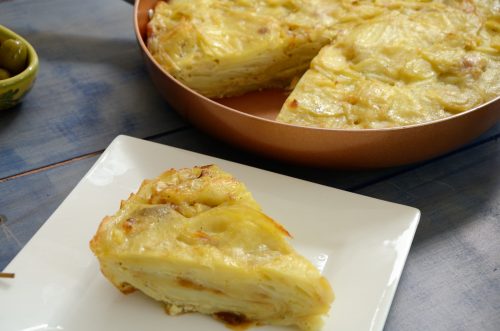
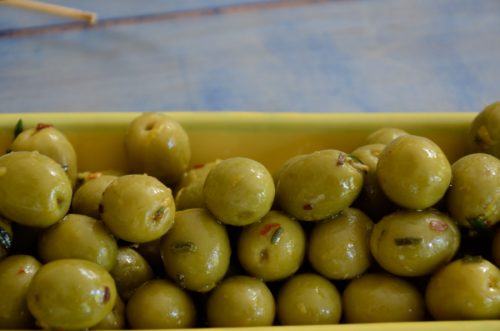
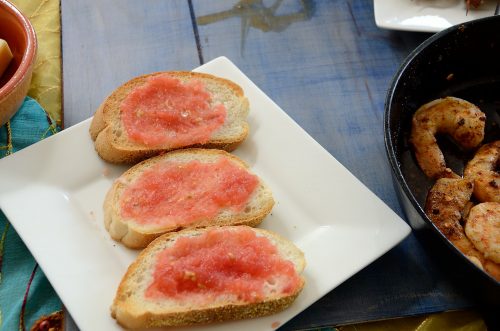
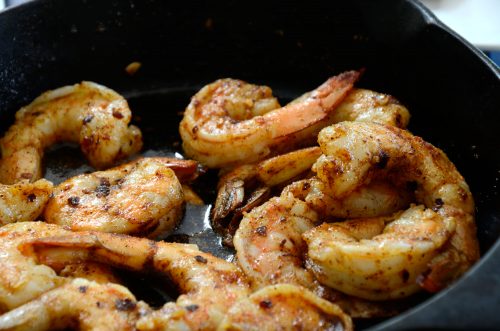
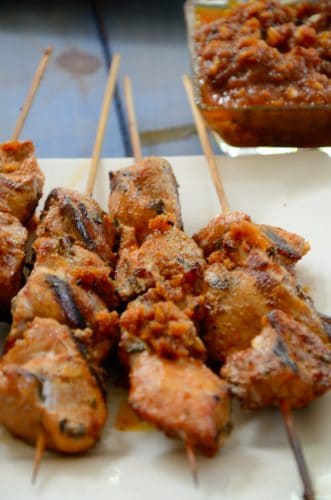
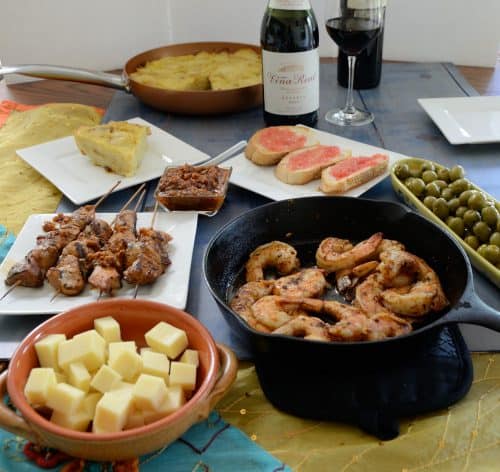
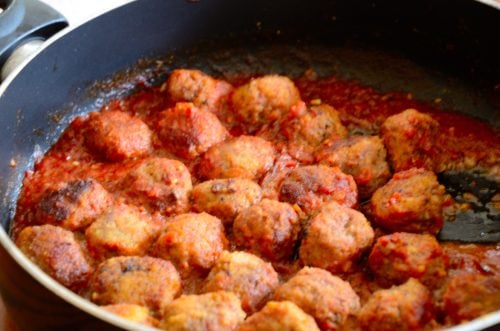
Leave a Reply